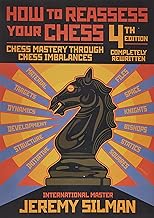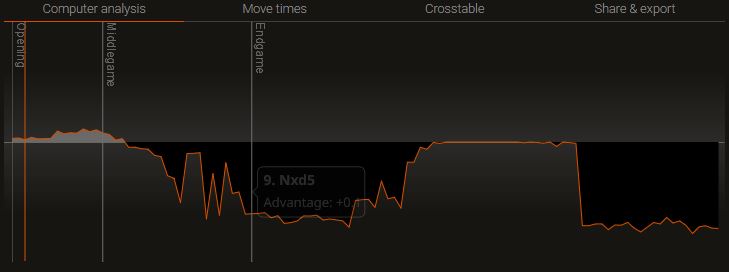Physical Address
304 North Cardinal St.
Dorchester Center, MA 02124
Physical Address
304 North Cardinal St.
Dorchester Center, MA 02124
Think you’ve hit your peak in chess? Think again. No matter where you are in your journey, there’s always room to grow. Let’s talk about how to improve chess skills in a way that actually leads to progress.

First, let’s break down the individual skills that make up a strong player. Chess requires several, including: tactics, strategy, endgames, opening knowledge, calculation, and positional understanding. All these skills contribute to a player’s strength. But which one is most important?
No single answer works for everyone, for two reasons. First, not all skills have the same importance at every level. Second, different players will have completely different weaknesses to address.
But we can generalize a bit. For most players, tactics and calculation should take priority. These are the foundation of strong play. Endgames come next, as they help convert advantages into wins. Strategy and positional understanding grow in importance as you progress. Finally, opening knowledge should happen in phases but not overemphasized early on.
To make the fastest improvement, you have to address your biggest weaknesses first. If you often lose to tactical oversights, focus on puzzles. If you struggle to convert winning positions, study endgames.
Of course, once you address one weakness, you have to reassess and repeat the process. Improvement isn’t about quick fixes. It’s about strengthening each part of your game, one after the other.
To summarize:
That’s the general plan for improving chess skills. But how do you put it into action? After all, recognizing your weakest areas isn’t enough. You need effective training methods to strengthen them.
In the next section, we’ll break down each critical chess skill. You’ll learn how to identify which ones you should work on, and how to go about it.
By following these practical steps, you’ll start to see real improvement in your games. Let’s dive in!
Contents

I like to divide chess skills into three broad categories: evaluation, strategy, and technical. The reason why will become evident in a moment, but first, let’s define them.
Evaluation is assessing a position and determining which side has the advantage. There are several factors that go into this assessment. These include material, piece activity, king safety, pawn structure, and others.
A strong evaluation ability saves time and prevents mistakes. If you know a position is bad, you won’t waste time calculating unnecessary variations. Instead, you’ll focus on the most promising plans. Plus, you’ll avoid blunders that come from misjudging the position. Without good evaluation, even strong calculation skills can lead to poor decisions.
A great resource for practicing evaluation is chessevaluationtraining.com. This tool challenges you with random chess positions. You need to decide which side has the advantage. Do this often enough, and you’ll sharpen your evaluation skills.
Go to the website and guess which side has the advantage in each position. If you get one wrong, open the position in Chess.com or Lichess. There’s a handy link for each site under the board that goes to each site. Then use the analysis tool to understand why your evaluation was incorrect. Play through the best moves to see what factor dominates the board.
Practice at least ten positions every day. Keep going until you get 10 out of 10 a few days in a row. You want to be both fast and accurate, but concentrate first on getting them right. Soon, evaluation will become second nature. Then you’ll be able to make better decisions in your games and save time on calculation.
Strategic skills relate to long-term strengths and weaknesses of a position. It involves making moves that improve your position over time. Strategy allows you to play with purpose, rather than reacting to your opponent’s threats. Here are some of individual skills in the strategy group.
Strong strategic skills allow you to make purposeful moves that shape the course of the game. Sure, tactics can win material or deliver checkmate. But strategy is how you reach favorable positions where those tactics can happen. Without strategy, your only option is to attack at random and hope your opponent blunders.

There are many excellent resources for studying strategic concepts. Chessable offers structured courses that break down strategic themes into digestible lessons. , allowing for interactive learning and spaced repetition. Resources like Chess.com or master courses can also provide valuable insights. For free options, try YouTube channels run by strong players. Choosing the right resource depends on your learning style and commitment level.
Unlike tactics, it’s hard to learn strategy through random puzzles. Instead, you need a training method that allows for focused repetition.
Chessable, for instance, lets you create your own custom courses. You can base these on positions from books, lessons, or analyzed games. You can then drill specific strategic themes either in sequence or random mode.
Note: it’s best to concentrate on one skill at a time. That way you’ll reinforce patterns and avoid spreading your training too thin.
You can’t study all strategic skills at once. Significant progress calls for serious focus. That means identifying which specific skill is causing most of you losses.
Some analysis tools will actually highlight your problem areas. They can even recommend specific skills to train. If that’s not an option for you, try reaching out in chess forums for some help. If you have money to spend, a chess coach can pinpoint your biggest issues with laser accuracy.
Whichever skill it is, focus on improving that specific area only. Use a course to practice around thirty strategic positions per day. Review them daily until your test scores improve. Then repeat the process with the next skill. Over time, this targeted approach will lead to huge improvements.
Technical skills form the foundation of strong chess play. These include tactics, endgames, and openings. In these three areas knowledge, pattern recognition, and precision are essential. They are far more “concrete” than strategic skills.
Let’s break them down.
Tactics are short-term move sequences that capitalize on immediate opportunities in a position. These include common patterns such as forks, pins, skewers, and checkmating combinations.
Strong tactical awareness is essential at every level of chess. Tactics, unlike strategy, can often win a game on the spot. This is especially true at the beginner level, where blunders often decide games. But even the best positional plans by a grandmaster can collapse if they miss a simple tactic.
Good tactical vision allows you to spot attacking chances and recognize hidden resources. Without a solid foundation in tactics, your chess development will stagnate. Not to mention your rating.
There are many excellent resources for improving tactical skills. For instance, Lichess offers free unlimited puzzles with difficulty adjustments. Chess.com provides a more structured training system with a paid account. Chessable also has courses focused on tactical patterns, and motifs. (I especially recommend courses by Dr. Can Kabadayi.)
The best way to train tactics is through solving puzzles. Start with random puzzles to test your general tactical awareness. Then filter by specific themes (such as pins) if you notice weaknesses in a particular area.
It’s important to solve puzzles at an appropriate difficulty level. Too easy, and you won’t improve; too hard, and you’ll struggle without reinforcing key patterns. Always take a moment to understand the full idea behind each solution. This is especially true if you get it wrong.
You should practice tactics daily, as it’s the most critical chess skill. Aim for at least 10-30 puzzles per day, adjusting the difficulty as you improve. If you solve most puzzles with ease, increase the level to challenge yourself. If you struggle, review the missed puzzles and focus on specific themes.
Over time, regular tactical training will sharpen your skills. Soon you’ll learn to recognize winning opportunities on the spot during your games.
The endgame is the final stage of a chess game when most of the pieces are gone. The focus shifts to king activity, pawn promotion, and precise calculation.
In the opening and middlegame, plans can be flexible. But endgames call for precise knowledge of key positions and techniques. A single mistake in the endgame can turn a won position into a certain loss.
A strong understanding of endgames is crucial at the intermediate level and above. You can convert advantages into wins or hold difficult positions to secure draws.
Many players spend too much time on openings but fail to convert winning endgames. due to a lack of basic knowledge. This is such a waste of valuable study time. Even a small material edge—like an extra pawn—can be decisive if you know how to play the endgame.
Looking for more benefits? Well, endgames can also improve your other chess skills. Many strategic and tactical ideas learned here will also apply to earlier stages of the game. Like visualization and calculation skills, for instance.
A good place to start is Lichess, which has great free interactive endgame lessons. Chessable offers structured endgame courses with spaced repetition. Books can be good resources too. Try Fundamental Chess Endings by Karsten Müller and Mark Dvoretsky’s Endgame Manual.
Whatever resources you decide on, you can also use Chessable to drill your positions. Create your own courses, then drill key positions until they become second nature.
The best way to practice endgames is to play them against a strong engine. You should repeat this until you can execute them without any mistakes. Start with basic checkmates (king and queen vs. king, king and rook vs. king). Then move on to simple king and pawn endgames. You’ll need to study fundamental principles like opposition and triangulation to master these.
When you’re ready, move on to rook and pawn endgames, the most common practical endgames in real games. Introduce the other pieces, one at a time, to build up your knowledge.
The method I use to this day is simple. I copied all the practical positions from Fundamental Chess Endings into a spreadsheet. Each row contains a description of the position, the target result, and a link. The link opens the position in Lichess (using FEN notation). I then click “Play against computer”, and play at the highest level possible. I stay on this position until I can win it (or draw) in my sleep.
Unless you’re a beginner, you don’t need to train endgames daily. A few times a week to reinforce key patterns is good enough. A good rule of thumb is to spend about half as much time on endgames as you do on tactics.
If you find yourself losing in the endgame, go back to daily training for a while. Stay at it until you can convert advantages and defend tough positions. Remember, a solid endgame is a powerful edge over opponents who neglect this part of chess.
A good opening gives you a solid position and a clear plan for the middlegame, but openings alone won’t win games. Tactics, strategy, endgames—these are the skills that decide most games. That said, knowing your openings helps you get a comfortable middlegame position. But it’s more important to understand opening principles. Don’t rely on memorizing long variations. Solid fundamentals will help you navigate the opening well, even without deep preparation.
There are many ways to study openings. If you don’t mind spending money, try courses on Chessable and Chess.com. To save money, go for free YouTube videos and Lichess studies.
Chessable is particularly useful for structured, interactive learning with spaced repetition. You can even make your own courses on Chessable if you want to study your own lines.
Chess.com offers opening databases and drills. Meanwhile, Lichess allows you to create your own studies and practice positions.
The best way to learn an opening is to create a personal Chessable course for each opening you play. Use its study function to drill your opening moves. The spaced repetition will help you memorize your lines in record time.
Don’t stop there, though. You should also study the typical middlegame plans associated with your openings. This makes your preparation more effective and practical. YouTube videos and paid courses are best for this.
You should only dedicate time to opening study when necessary. Do you keep forgetting your lines or find yourself losing games early due to poor opening play? If so, that’s a signal that you need to address your openings.
If you lack confidence in your opening repertoire, take a second look at the lines that give you problems. Replace them if necessary. Then drill them until they become second nature.
Don’t overload yourself with too much theory. Instead, focus on understanding reasons behind each move. If you add a new opening to your repertoire, introduce it a bit at a time. Practice it in training games or against bots before using it in serious play.
There’s no single answer to this question. To improve your chess skills, you need to identify which skills are holding you back. The best way to do this is by analyzing your past games with a chess engine. Look at the evaluation score (“eval”) after each move to see where your weaknesses lie.

By identifying these trends, you’ll get the most value for your training time. Focus on the areas that will give you the fastest improvement, and your rating will soar.
What if you’re still not sure where you struggle the most? In that case I would stick to tactics and endgames. These two areas have the most immediate impact on your performance. They should make up the majority of your study time anyway.
Don’t ignore strategic concepts, though. They help you navigate complex middlegame positions and avoid drifting without a plan. Good tactics arise from good positions. Good positions come from good strategy.
While openings should never be your main focus, review them as needed. At the very least, make sure you understand opening principles.
As much as possible, structure your study around your personal weaknesses. That way you’ll see steady and meaningful improvement over time.
Improving chess skills isn’t about memorizing openings or hoping for lucky tactics. It’s about training the right skills in the right way. By breaking chess down into specific skills, you can identify your weaknesses. Then you can focus your study time where it matters most. Use game analysis to find your problem areas. Build a training routine that emphasizes those weaknesses, and turns them into strengths.
The best way to start is to take action today. Analyze your last few games. Identify a key weakness, and commit to a training plan that addresses it. It doesn’t matter which skill it is, get started. Then keep going. Consistent effort will lead to noticeable improvement. Train with purpose, track your progress, and watch your chess skills grow. The path to mastery starts now!

[…] When I started playing chess over 50 years ago, the internet didn’t exist. Computers existed, but only in the basements of government offices and large businesses. Back then, if you didn’t have a coach, then books were your only option for improving your chess skills. […]